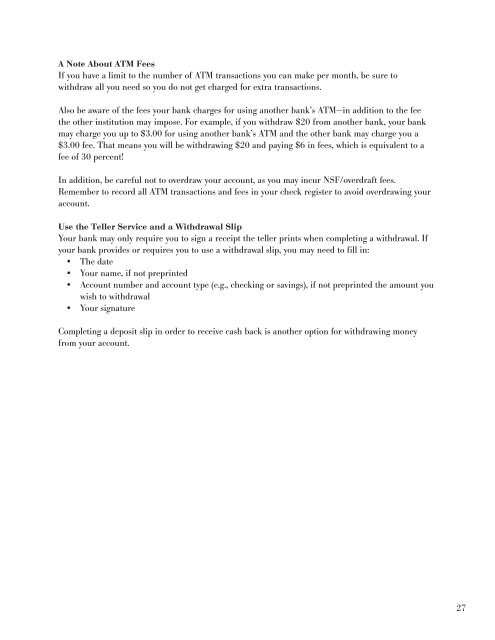Tips and Tools For Financial Success - Newton Free Library
Tips and Tools For Financial Success - Newton Free Library
Tips and Tools For Financial Success - Newton Free Library
You also want an ePaper? Increase the reach of your titles
YUMPU automatically turns print PDFs into web optimized ePapers that Google loves.
A Note About ATM Fees<br />
If you have a limit to the number of ATM transactions you can make per month, be sure to<br />
withdraw all you need so you do not get charged for extra transactions.<br />
Also be aware of the fees your bank charges for using another bank’s ATM—in addition to the fee<br />
the other institution may impose. <strong>For</strong> example, if you withdraw $20 from another bank, your bank<br />
may charge you up to $3.00 for using another bank’s ATM <strong>and</strong> the other bank may charge you a<br />
$3.00 fee. That means you will be withdrawing $20 <strong>and</strong> paying $6 in fees, which is equivalent to a<br />
fee of 30 percent!<br />
In addition, be careful not to overdraw your account, as you may incur NSF/overdraft fees.<br />
Remember to record all ATM transactions <strong>and</strong> fees in your check register to avoid overdrawing your<br />
account.<br />
Use the Teller Service <strong>and</strong> a Withdrawal Slip<br />
Your bank may only require you to sign a receipt the teller prints when completing a withdrawal. If<br />
your bank provides or requires you to use a withdrawal slip, you may need to fill in:<br />
• The date<br />
• Your name, if not preprinted<br />
• Account number <strong>and</strong> account type (e.g., checking or savings), if not preprinted the amount you<br />
wish to withdrawal<br />
• Your signature<br />
Completing a deposit slip in order to receive cash back is another option for withdrawing money<br />
from your account.<br />
27




